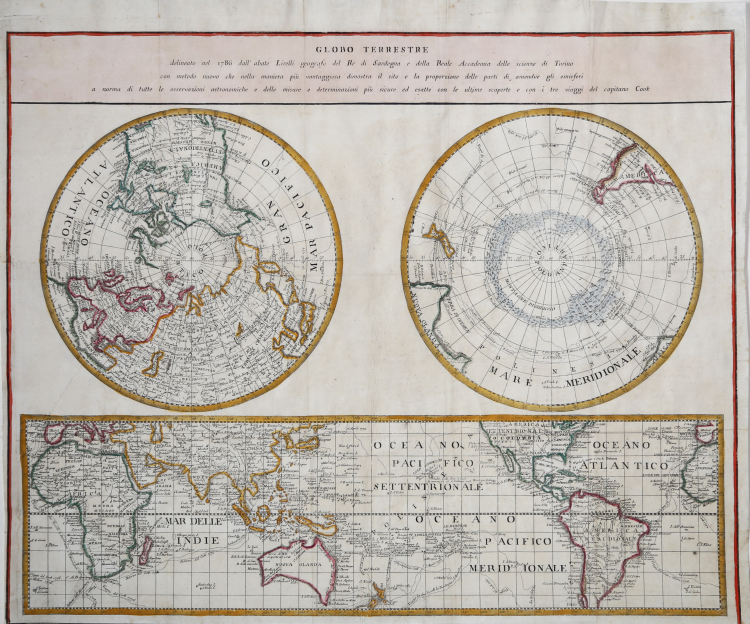



| Reference: | S46314 |
| Author | Salvatore LIRELLI |
| Year: | 1790 |
| Zone: | The World |
| Printed: | Venice |
| Measures: | 470 x 385 mm |


| Reference: | S46314 |
| Author | Salvatore LIRELLI |
| Year: | 1790 |
| Zone: | The World |
| Printed: | Venice |
| Measures: | 470 x 385 mm |
World map in Mercator projection (12.5:43.5 cm) and in 2 hemispheres in polar projection resp. (Ø 19 cm each).
Etching, after Salvatore Lirelli; engraved by P. Amati and P. Tela, circa 1790.
This uncommon map is a slightly-reduced version of Salvador Lirelli's map, which was published in 1786 for the Royal Academy of Science in Torino. The sheet includes two polar projections and a world map on Mercator's projection, centered on the Pacific. The focus of the maps is Captain Cook's voyages, which are traced throughout along with the dates of each leg of his travels. The south polar hemisphere depicts mountains of ice surrounding the pole, but no landmass is shown. The map on Mercator's projection shows Australia named Nuova Olanda and still connected to Tasmania, although the coastline is beginning to take shape.
In his map, Lirelli explains that he made this map to offer readers a new perspective on the world. This is achieved through the dual-projection of the earth presented in three parts. In the memoir placed between the hemispheres, Lirelli explains the choice to include both projections. The Mercator Projection at the bottom is excellent for calculating distance for navigation, but it is not as reliable at high latitudes. For those Polar Regions, a Polar Projection is superior, hence his inclusion of both so that the reader can jump between the two for a more accurate understanding of the globe. The southern hemisphere is particularly intriguing as there is no Antarctica, for it was still unknown to navigators and geographers. Instead, Lirelli has hypothesized that the pole is surrounded by mountains of ice, a guess not far from the truth of the cold continent.
Ranged below the two hemispheres is the world on a Mercator projection. The poles have been removed, with latitude ranging only to 45° N and S. On both projections, the dates of European land encounters are marked. New Holland is still connected to Van Dieman's Land, as this map was made before Flinders' second voyage, but New Guinea and New Holland are no longer hypothesized to connect, separated instead by the Endeavour Strait. On both the southern hemisphere map and the Mercator Projection, New Zealand is remarkably accurate.
According to the Memoires de l'Academie Royale des Sciences de Turin, Lirelli presented a manuscript version of this work to the Society for review. The academicians were impressed, complementing the way it made map reading easy due to the close-up view of the usually hard-to-see Polar Regions. They granted the map their approval and named Lirelli a geographe du roi.
The Academie in Turin was part of Italy's resurgence in the sciences in the late eighteenth century. Enlightenment ideas had reached northern Italy in the 1740s, helped by the election of a progressive Pope, Benedict XIV. In 1757, the Turin academic Cesare Beccaria began a scientific society with some of his students. It was first called the Societas Privata Taurinensis but was later renamed the Societe Royale des Sciences. Victor-Amadeus, the King of Sardinia, was the Society's patron, hence the dedication of Lirelli's map. The King made the Society official in 1783, just three years before this map was made, and the name changed again to the Academie Royale des Sciences. The Society still exists today, under the name Accademia delle Scienze di Torino.
Lirelli worked in Novara, and became director of the observatory in Turin in 1791. He was born in 1751 and died in 1811. The 1780s were an active period for him, as he also published a geographic analysis meant to accompany a new atlas of Europe in 1789.
A very good example with fine later hand colour, perfect condition. Rare.
Bibliografia
Tooley, Mapmakers I, 26 (A.) u. III, 141 (L.); cf. Tooley, Antarctica 79.
Salvatore LIRELLI(1751-1811)
Salvatore LIRELLI(1751-1811)